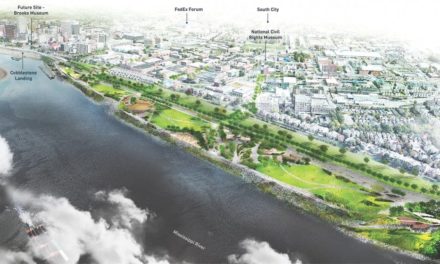From Pittsburgh Post-Gazette:
As the bus lumbered through the city on a day that cried for shade, Arthur “Butch” Blazer fanned the barely conditioned air with his black Western hat. At every turn, trees swept past the windows — the mature canopy in Allegheny Cemetery, the new line of saplings in the median on Penn Avenue in East Liberty — until the bus stopped in North Point Breeze at Tree Pittsburgh’s seedling nursery.
Mr. Blazer, the U.S. Agriculture Department’s deputy under secretary of agriculture for natural resources and environment, joined Tree Pittsburgh’s Thursday afternoon tour, after which it presented its urban forest master plan at an evening reception at Bar Marco in the Strip.
The $275,000 plan resulted from two years of data collection, analysis, consultations and benchmarking, and the USDA helped pay for it.
“The master planning process here is extremely important because it connects to the president’s Great Outdoors Initiative,” Mr. Blazer said. “When people think ‘great outdoors,’ they think of places like Yosemite. They need to start thinking about places like Pittsburgh, too. Eighty percent of our country’s population is in urban areas, and we know the importance trees have on the psyches of humans.”
The master plan reports the city has more than 2.5 million trees that sequester 13,900 tons of carbon dioxide a year, saved residents $3 million in energy bills last year and remove 519 tons of pollution at a savings of $3.6 million a year. Street trees alone diverted 41.8 million gallons of stormwater last year.
Research for the master plan used new Forest Service technology that takes data and spits out environmental impact.
Danielle Crumrine, executive director of Tree Pittsburgh, said the plan will spur tree advocates to increase the size of the canopy, improve its condition, diversify its species and plant in neighborhoods that have been neglected. Although 42 percent of the city is covered in trees, most of the canopy is in parks and more affluent neighborhoods.
At the nursery, high school students from Homewood’s Junior Green Corps, an Operation Better Block job training program, were harvesting seeds and planting under a tent at the back of the nursery, which was established two years ago in part with a grant from The Sprout Fund.
Kahlil Morris, a supervisor of the Green Corps, said all 21 participants are training to be Tree Tenders, a volunteer program run by Tree Pittsburgh to teach residents about the proper care and pruning of trees.
“We want to keep this partnership,” he said. “It’s a cool program and it’s close” to Homewood.
“I’m excited to see the work these young people are doing and the things they are learning,” Mr. Blazer said. “As you implement your plan and improve upon your urban forest, we on the federal level can work with the city and local organizations to create more opportunities for young people.”
Mayor Luke Ravenstahl noted that the plan calls for a canopy increase of 20 percent over 20 years and added, “We stand committed to doing everything we can to fulfill those goals.”
A 2005 street tree inventory by the Davey Resource Group counted 31,524, half of what people in the field had expected. The forestry budget didn’t even start to reach the branches in need of pruning.
A year later, Tree Pittsburgh was founded as Friends of the Pittsburgh Urban Forest by the Shade Tree Commission as an independent nonprofit. It began raising money to reverse the decline of the city’s trees. Treeless street areas became a more generous 30 square feet and a city-county, nonprofit collaboration created TreeVitalize with state funding to plant 20,000 trees in four years. Jeff Bergman, director of TreeVitalize, said 15,000 have been planted so far.
The Davey Resource Group managed and wrote Tree Pittsburgh’s new master plan and Matt Erb, a Tree Pittsburgh arborist, oversaw the data collection at more than 200 random one-tenth acre plots.
Josh Behounek, an urban forester for Davey, said the firm has done “a half-dozen master plans. But with green infrastructure and sustainability concerns, it is happening more. What popped for me [about Pittsburgh] is the amount of knowledge people already had. I can’t think of any other master plan [city] with this much knowledge of its urban forest.”




